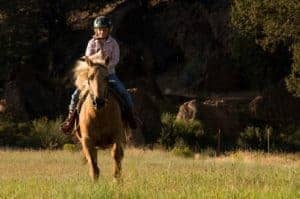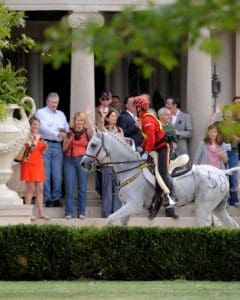How to help performance horses of all types reach peak fitness. (thehorse.com)
That competitive edge. It might look different for different disciplines, but this intangible has its roots in the same concept: conditioning. In short, conditioning develops the musculoskeletal, neurologic, and cardiovascular systems so they can perform athletic endeavors with the greatest efficiency and the least stress on the body.
In this article we’ll learn how riders from different disciplines condition their horses. While there is no magic recipe fit for all equestrian sports, the basic principles of conditioning remain the same across the board.
The Basics
To get fit for competition, your horse needs to be “legged up,” which entails preparing the musculoskeletal system to withstand a certain amount of impact, speed, and duration of work. Then you build upon this foundation in a stepwise fashion, first increasing distance at the walk and trot and then increasing intensity to include canter/lope and gallop and/or incline work. The initial exercise demand (completed at the walk, trot, slow canter) is generally known as long, slow distance (LSD) training, and it develops the cardiovascular system and aerobic energy pathways to fuel the muscles.
Aerobic metabolism occurs when muscle cells use energy sources in the presence of oxygen. Higher intensity exercise, such as sprints, gallops, difficult hill climbs, or jumping efforts, requires rapid muscle metabolism that taps into other energy sources in the absence of oxygen.
Use a heart rate monitor to assess your horse’s progress in real time; heart rates between 130 and 150 beats per minute (bpm) indicate a range that will improve fitness.
Building on this LSD foundation, many riders integrate strength-training exercises (such as hill work) and interval training (IT) speed work into their conditioning program to stimulate anaerobic efforts. Interval training involves sprints over a defined distance and/or time. To reach a training effect that taps into anaerobic fuel sources, the horse’s heart rate must exceed 165 bpm for at least two minutes.
As a horse develops a more robust respiratory and cardiovascular system and stronger muscles, soft tissues, and bone, he’ll probably seem more confident and eager to perform his work. Efforts that once raised his heart rate dramatically and caused him to breathe hard and sweat a lot will come more easily. The stronger he becomes, the lower his risk for getting injured and the less soreness he’ll experience.
Sport-specific training is essential to getting the best results in your particular competition arena. Let’s now look at how conditioning strategies differ between equine sports.
The Endurance Horse
This athlete is conditioned to perform over long distances—usually 50 or 100 miles across tricky terrain—for extended periods. Horses participating in American Endurance Ride Conference events must complete 50-mile rides within 12 hours and 100-mile rides within 24 hours.
These horses undergo physiological changes at specific heart rates to develop condition. For this reason, endurance riders use onboard heart rate monitors to track their horses’ work output and evaluate how they’re handling exercise demands, allowing them to maximize their training effort.
It takes years to develop an endurance horse to peak fitness. Riders must follow a steady training program that includes at least two to three months of LSD, followed by strength and speed training.
A safe approach involves asking a horse for incremental increases in distance or difficulty every five days. This gives his body time to adjust to the new intensity before advancing to the next level of effort. Owners should monitor their horses for signs of stress during this process, including limb swelling or soreness, a lapse in appetite, or a change in attitude.
Strength training over six to 12 months should double a horse’s muscular strength. Hill work for horses is similar to weight-lifting, which has been shown to reduce the risk of musculoskeletal injuries in people by more than 50%. Muscles push against greater resistance as a horse moves his mass (plus the rider’s weight and tack) up a hill. Other drills for developing muscular strength include dressage work, cavalettis, jumping gymnastics, or work in deep footing such as sand. Strength-training exercises two to three times a week develop muscle strength as well as cardiovascular condition.
After at least five or six months or a solid first season of LSD conditioning and strength training, many riders add IT to their repertoire. This teaches the body to deal with the byproducts of anaerobic metabolism. The horse must work at a high enough intensity to drive his heart rate over 165-180 bpm. You can accomplish this with flat gallops or trot and canter sets up hills. These stress periods only need to last two to three minutes for the tissues to gain some training effect in the anaerobic mode. Then bring the horse back to a working heart rate of less than 150-160 bpm for tissue recovery.
Heart rate recovery is an important measure of how well a horse is coping with exercise demands. You want a horse to recover to a heart rate of 60-64 bpm as quickly as possible when exercise stops. Fit horses ridden to their level of ability generally reach this level within two to three minutes, and at least within 10 minutes. Any time beyond that recovery period suggests that:
- The horse is being asked to go too fast for his level of conditioning and/or the trail and weather conditions;
- The horse is developing metabolic issues; and/or
- The horse is experiencing musculoskeletal pain.
Another way you can determine whether an endurance horse is “fit to continue” is by measuring his cardiac recovery index (CRI). Record the heart rate (count the heartbeats for 15 seconds, then multiply by four) and then time the horse as he trots 250 feet. Exactly one minute after recording the heart rate, measure it again. The heart rate should return to the resting rate or below (as for example, 64/64 and 64/60) following that trot-out. If the rate is higher, evaluate the horse’s vital signs and metabolic parameters as a veterinarian would at a ride vet check: mucous membrane color, capillary refill time (how long it takes for the horse’s gums to refill with blood after you push on them—ideally, one to two seconds), skin turgor (elasticity when pulled, an indicator of hydration), jugular pulse, intestinal sounds, muscle tone, anal sphincter tone (the tightness of the muscle around the anus), and attitude and impulsion.
Throughout the conditioning and competition process, assess all these parameters, as well as soundness, so you can detect and deal with any subtle problems immediately. And, of course, work with your veterinarian to keep these athletes in peak condition, health, and soundness.
To read more on conditioning for the eventing, race horse and the western performance forse, click here!
Take-Home Message
Developing a prospect is a lengthy project, often requiring years to reach the horse’s performance peak. It is important to outline your goals and construct a conditioning strategy around your horse’s starting point. Learn how different organ systems respond to training as well as the demands of your desired discipline. Taking the time to build a structural foundation will pay dividends in a horse’s future performance.
In all these efforts, working with a veterinarian knowledgeable about your sport is instrumental to keeping a horse healthy, sound, and fit. Basic husbandry practices, nutrition, and preventive medicine all contribute to these athletes’ success.












